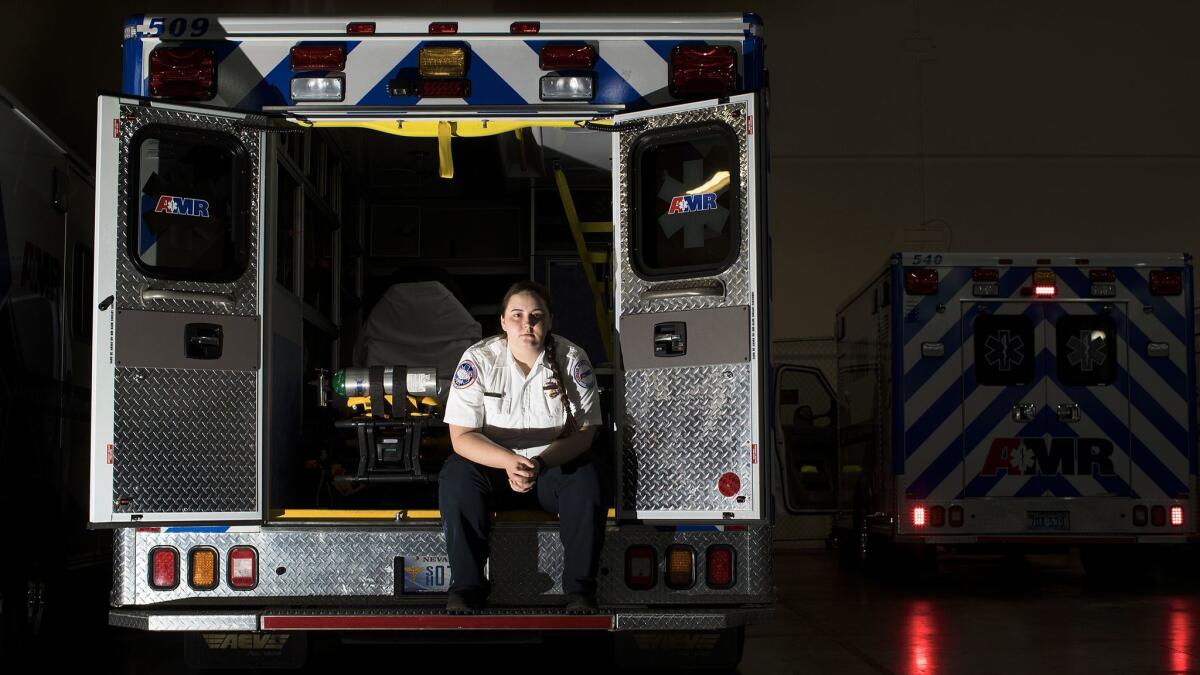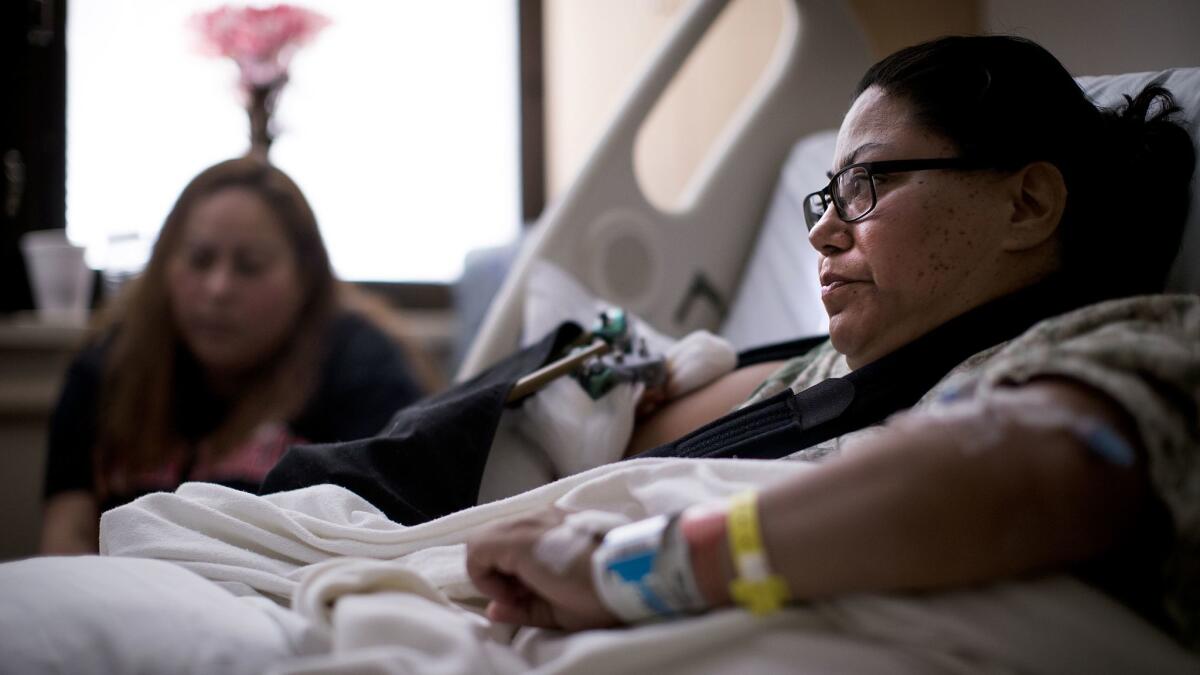The frantic, bloody hours in a Las Vegas hospital as doctors rushed to save lives

What happened inside Sunrise Medical Center in the hours after a gunman wounded hundreds in Las Vegas.
The chatter from a police radio instantly caught the attention of Kevin Menes, the senior doctor on duty Sunday night at one of the busiest emergency rooms in Las Vegas.
"Automatic fire." "Look for the shooter."
As more information came in — country music concert, Mandalay Bay on the Strip — his mind started spinning.
Menes had rehearsed this scenario in his head.
Four ER doctors and one trauma surgeon were on duty that night at Sunrise Medical Center. Menes needed more anesthesiologists, more trauma surgeons, more technicians, more nurses.
He needed more gauze, more chest tubes, more operating rooms left open, more gurneys and wheelchairs lined up in the concrete bay where ambulances would soon be arriving.
He ordered everything he could. It was about 10:30 p.m.
With a nurse at his side, Menes waited outside for the deluge of the fallen, ferried by cars, ambulances, taxis, Ubers and pickup trucks.
He had only seconds to assess each patient. The walking wounded got a green tag. Those seriously injured but who could be stabilized got yellow. Those on the brink of death — pale complexion, thready pulse — got red.
In 40 minutes, Menes saw about 150 patients. Maybe 50 of them had red tags.
Menes was needed inside. He turned to the nurse next to him.
“You saw what I’ve been doing, right?” he said. “I want you to take over and do exactly what I was doing.”

Paramedic Amber Ratto and her partner were parked in their ambulance outside Southern Hills Hospital when they heard the call.
This can’t be happening, 26-year-old Ratto thought.
The pair sped to Russell Road and Las Vegas Boulevard, one of the staging areas for the wounded.
“Can you take a gunshot wound to the abdomen?” a firefighter asked.
Blood streamed from the torso of a 51-year-old man. Ratto opened the ambulance doors, and the man walked in and laid on the gurney.
“Can you take more?” the firefighter asked, pointing to a woman with a gunshot wound to her head.
“Give her to me,” Ratto replied, and strapped the woman to a seat.
They left within less than a minute, dodging abandoned cars and fleeing concertgoers as they weaved through traffic on the six-mile drive to Sunrise.
In the back, Ratto surveyed her patients, a married couple. The man’s vitals were declining fast. He was pale, cold and sweaty, and as the seconds passed, increasingly sluggish.
She pressed bandages to his side and taped his wound as hard as she could. His heart slowed, so she put in an IV.
Despite the gunshot to the head, the woman was alert and chatty, but possibly inebriated and not listening.
Ratto grabbed the woman’s face and said: “Stop. Do exactly what I say. Listen to me. I’m trying to stop him from dying.”
The ambulance pulled into Sunrise.
“What do you have?” a nurse asked Ratto.
“He needs to go now,” she replied. “He’s red. He’s red.”
Ratto and a firefighter who rode in the ambulance with her wheeled the man to the trauma unit.
“He’s critical,” she told the surgeon.
“I want him now,” he replied.
He asked Ratto if she had intubation equipment in her ambulance. She raced outside to retrieve it, then helped intubate the patient.
Next to them was a man who had been shot in the neck. Another bed held a dead body, already covered in a sheet.
Ratto helped the surgeon wheel her patient to the operating room. Her work ended at the operating room door.
Her gurney was returned empty seconds later. Ratto ripped off her bloody gloves and pushed it back to her ambulance. She cleaned the blood off her arms while her partner drove back to pick up more victims.
Emergency room protocol generally calls for at least one nurse for every two to four patients.
Now each nurse was monitoring eight patients at a time, sometimes more. From their station, the nurses would look for those who were fading.
“The second they start crashing, I need to know,” Menes told them.
Some of the victims wailed. Blood pooled on the floor. Debris from bandages piled up. Housekeeping could not clear the floor fast enough.
With rooms overflowing, Menes and his staff began resuscitating patients in the hallways.
There was no time to order X-rays or conduct other procedures normally used for patients with possible collapsed lungs, which are common in people with gunshot wounds to the chest.
Menes focused on finding bullets holes. That was all that mattered. It barely registered whether the patient was young or old, a man or a woman.
He’d finish with a patient and look up to scan the room.
“Who was critical? Who was crashing?” he’d think.
He knew that the flow of patients was the most important thing. He worried that one might accidentally be overlooked and wind up under a desk and die.
It fell to Dr. David MacIntyre and other surgeons to decide who went into an operating room first.
Belly wounds took priority. A bullet to the chest could be stabilized to buy some time. Gunshot wounds to the head sometimes had to wait before getting attention from a neurosurgeon.
All 20 or so beds outside the operating rooms were being used.
Dr. Stephanie Davidson, an anesthesiologist, kept a list of open surgical pods on her hand, conducting traffic.
“A1, D3, B2,” she called out. “You can go to B2.”
Not everyone who needed surgery made it into an operating room.
The dead went to the makeshift morgue, a gastrointestinal lab adjacent to the suite of operating rooms. FBI staff and forensics agents worked inside, trying to identify the victims by their fingerprints. The doctors would make the phone calls to family.
Several Las Vegas police stood outside the morgue in the hallway, one holding an American flag folded in a triangle.
One of their colleagues was among the dead.
MacIntyre had to pass the morgue each time he took a new patient to surgery.
At 4 a.m., he grabbed a Coke from the soda machine in the trauma bay, guzzled it and took a minute to breathe. He feared another wave of patients was coming.
By daybreak Monday, more than 100 doctors and nurse practitioners at Sunrise had tended to roughly 200 patients, nearly all with gunshot wounds. By Tuesday, 16 had died. Dozens remain in critical condition.
Menes left the hospital around 6 a.m. and stopped by the Las Vegas police command post to see whether any help was needed there. Sleep would come later.

Amid the carnage, 39-year-old Paola Bautista found comfort and levity, despite a gunshot wound to the arm.
“You are alive. You are safe,” nurses reminded her and the others. It was a refrain that she could not hear enough.
From her bed, Bautista turned to the man next to her, who was in a wheelchair. He’d had a bullet pierce the back of his skull.
“I don’t know how I’m alive,” he told her.
Twitter: @MattHjourno
ALSO
How to stop a sniper like Stephen Paddock? Police sharpshooters firing from helicopters is one idea
Here's what we know (and don't know) about the Las Vegas shooting
Why did it take police so long to breach Las Vegas gunman's room? Here's a new timeline
Sign up for Essential California
The most important California stories and recommendations in your inbox every morning.
You may occasionally receive promotional content from the Los Angeles Times.








